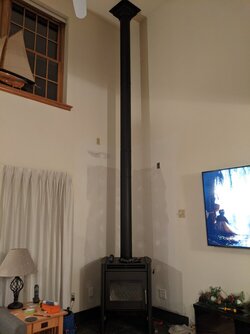Hey All - First time using a free standing stove and I'm not sure I'm doing everything 100% right, since as the title suggests, I think I may have had a small chimney fire tonight. I have a new BK Chinook 30.2 and I've been using it for a few weeks since finishing the install. I haven't burned much in the past week since temps in my area have been pretty moderate (Delaware has been in the 50's or higher). So tonight it's getting cold again and I loaded up the box to start the fire. Fire got going well, and was pretty hot with it hitting the "Active" zone right about 18 minutes when I closed the bypass. Manual says to keep the thermostat on high for a good fire for 20+ minutes to help burn off the creosote in the box and char the new wood, and tonight at about the 20 minute mark, I could hear something strange, which was best described on other threads here as rice-krispies running down the stove pipe. As soon as I realized what it was, or at least what it may be, I turned down the stove and the noise stopped within about 20 seconds. It was making that noise for around 90 total seconds between me hearing it, using a laser thermometer on the interior stove pipe, going outside to look at the chimney, and coming back in and to turn the stove down. The interior double wall pipe was about 230-250* exterior temp to about 8' up, then under 200* up to where it enters the ceiling box. The Chimney outside had no signs of anything wrong - No sparks, just light/white smoke that seemed normal and showed no temp increase above ambient, if the laser thermometer even works that far away.
So here is the real question - Do you think it was an actual chimney fire or am I just being paranoid?
I am seeing more creosote inside the fire box and on the glass then I was used to in my last Osburn insert, and I'm not sure if that's normal or not. I'm burning seasoned wood that is under 20%, at least on the pieces I've checked, but will check more to make sure. Wood I'm on now is a bit of a mix of species, but all hard wood. During the steady-state burn, I normally run the thermostat at around the 4:00 position and I'm very happy with the 12+hr run times and it's all the heat my house needs. Do I need to run hotter and just vent with outside air?
I know a double wall stove pipe thermostat would have been helpful in diagnosing issues, and one is on order now.
I'm just a little nervous about next time I run it on high with a new load of wood? Is there anything else I should do other make sure I watch things closely?
I don't have the equipment to clean the chimney myself at the moment, but was planning on buying and cleaning things in the spring. Should I get it cleaned/inspected by a professional sweep soon? Or even immediately before I continue use?
Thanks and sorry for all the questions. Did a lot of reading tonight but didn't see much about what happens after a small fire like this, only bigger fires and damaged equipment.
Don
-

So here is the real question - Do you think it was an actual chimney fire or am I just being paranoid?
I am seeing more creosote inside the fire box and on the glass then I was used to in my last Osburn insert, and I'm not sure if that's normal or not. I'm burning seasoned wood that is under 20%, at least on the pieces I've checked, but will check more to make sure. Wood I'm on now is a bit of a mix of species, but all hard wood. During the steady-state burn, I normally run the thermostat at around the 4:00 position and I'm very happy with the 12+hr run times and it's all the heat my house needs. Do I need to run hotter and just vent with outside air?
I know a double wall stove pipe thermostat would have been helpful in diagnosing issues, and one is on order now.
I'm just a little nervous about next time I run it on high with a new load of wood? Is there anything else I should do other make sure I watch things closely?
I don't have the equipment to clean the chimney myself at the moment, but was planning on buying and cleaning things in the spring. Should I get it cleaned/inspected by a professional sweep soon? Or even immediately before I continue use?
Thanks and sorry for all the questions. Did a lot of reading tonight but didn't see much about what happens after a small fire like this, only bigger fires and damaged equipment.
Don
-


